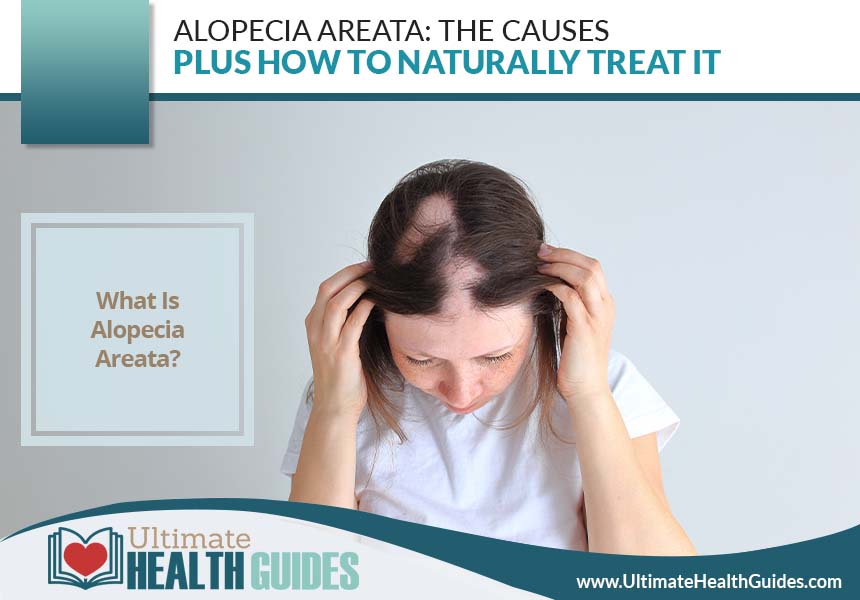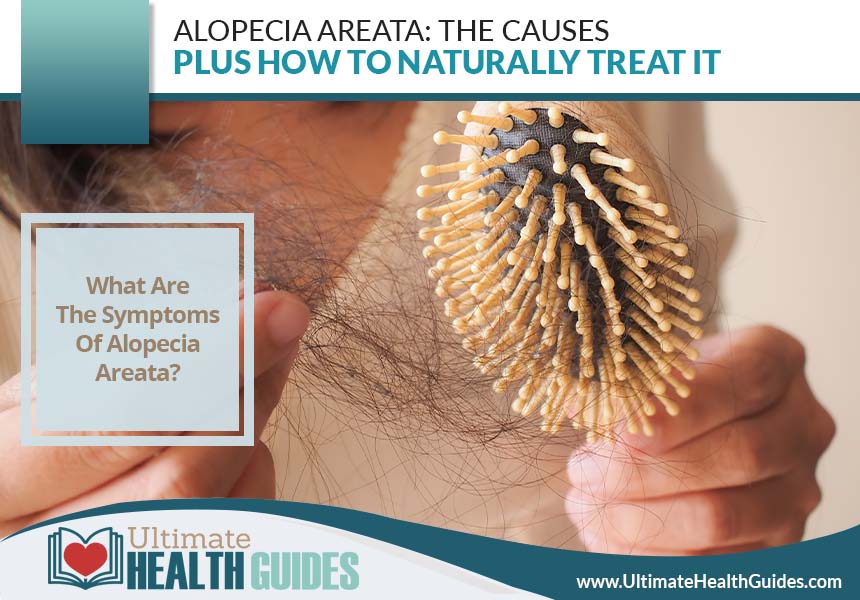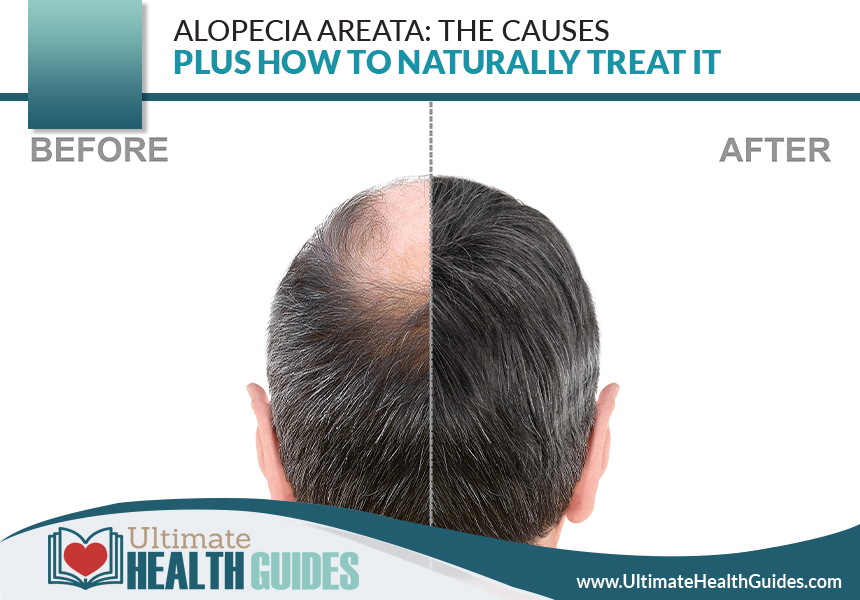Alopecia areata is a hair condition that can cause patches of the hair to fall out not only from the scalp but from other areas of the body as well. Scientists believe this to be an autoimmune disorder, which means that occasional flare-ups may happen when the immune system mistakenly attacks healthy cells by accident. Although there is no cure for alopecia areata, don’t worry! There are still conventional treatments and natural remedies available that can help improve your symptoms in addition to boosting your immune system overall. Keep reading below to learn more about how you can better deal with alopecia areata!

What Is Alopecia Areata?
Alopecia, meaning “baldness” in Latin, is a condition thought to be caused by the immune system attacking healthy tissue. Areata, which comes from the Latin word “area,” refers to balding patches on the scalp or hair loss on other areas of the body. Though alopecia areata can happen at any age, it’s most common in teenagers and young adults; however, there is no cure yet – treatments only help with regrowth.
Alopecia areata is often misdiagnosed because it manifests as patchy hair loss. The most typical form of alopecia areata is referred to as “patchy alopecia.” With this type, baldness appears in the form of one or more patches on the scalp. These patches usually appear round or oval-shaped. Patchy alopecia can affect anyone at any stage in life, although it is most common among adults. It can also show up on other parts of the body, like beards, eyebrows, or eyelashes.
“Alopecia totalis” and “Alopecia universalis” are both types of alopecia. Alopecia totalis causes the loss of all scalp hair, while Alopecia universalis leads to the loss of all body hair. The amount of hair loss due to alopecia varies from person to person – some may only experience thinning patches, while others can lose nearly all their hair. In extreme cases, outright baldness is possible.

What Are The Symptoms Of Alopecia Areata?
There are some common symptoms of Alopecia areata, and below are some of them.
Hair loss: Hair loss can occur on the scalp as well as in other areas of the body. Hair loss often appears in patches, but it can also be more widespread.
Bald spots: The bald spots may be round or oval, and they can occur on the scalp or in other areas of the body.
Hair thinning: With hair thinning, the hairs become thinner and weaker. This can lead to breakage and fallout.
Receding hairline: This can occur on the scalp or in other areas of the body.
Changes in the fingernails: The changes may include ridges, dents, or pitting.
Depression and anxiety: Hair loss can be emotionally devastating, and many people struggle with depression and anxiety as a result.
Thyroid disease: The thyroid is a gland in the neck that regulates metabolism. When the thyroid is not functioning properly, it can cause a variety of symptoms, including hair loss.
Vitiligo: Vitiligo is a condition that causes the skin to lose color. This can occur in patches or over the entire body.
Lupus: Lupus is an autoimmune disease that can cause a variety of symptoms, including hair loss.
Rheumatoid arthritis: Rheumatoid arthritis is an autoimmune disease that causes inflammation of the joints. This can lead to pain, stiffness, and swelling.
Inflammatory bowel disease: This is a group of conditions that cause inflammation of the digestive tract. Symptoms can include abdominal pain, diarrhea, and weight loss.
Psoriasis: Psoriasis is a condition that causes the skin to become inflamed and scaly. This can lead to itching, redness, and flaking.
Experiencing these symptoms could be a good indicator that you have Alopecia areata; however, the only way to know for sure is to see a doctor. They will likely do a physical examination as well as order blood tests. These tests can help rule out other conditions that may be causing your symptoms.

What Are Alopecia’s Causes And Risk Factors?
Alopecia areata is an autoimmune disease that causes the white blood cells to attack healthy hair follicles, resulting in shrinkage and a hindrance to natural hair production. Although it can technically affect anyone, it’s most common in young adults and children and occurs with equal frequency among both sexes. Additionally, people who have certain other autoimmune diseases, such as thyroid disease, lupus, or rheumatoid arthritis, are more likely to develop alopecia areata at some point in their lives.
Alopecia areata may be caused by chronic stress, which affects the body’s immune system. Environmental factors, such as exposure to chemicals in hair dyes and perms, can also trigger an autoimmune reaction that causes hair loss. The disease typically follows a seasonal cycle, with more hair loss occurring in the springtime due to higher viral and bacterial infection rates.
There is no one definitive cause of alopecia areata, but environmental factors, such as exposure to chemicals in hair dyes and perms, can trigger an autoimmune reaction that causes hair loss. The disease usually goes through seasonal cycles, with more hair falling out in the spring because there are higher viral and bacterial infection rates at this time. Alopecia areata cannot be spread from person to person, nor is it caused by poor hygiene habits.
There is no cure for alopecia areata, but there are treatments available that can help hasten hair regrowth. The most typical treatment is corticosteroid injections, which help reduce inflammation and promote natural hair growth. In some more severe cases, topical immunotherapy may be administered, involving the application of a chemical to the scalp. Another experimental method used in light therapy destroys immune cells attacking healthy hair follicles by using lasers or other forms of concentrated light waves.

Are There Natural Remedies For Treating Alopecia Areata?
There are conventional ways to treat alopecia areata, such as with corticosteroids. However, using natural ways to treat alopecia areata can be very successful. Here are some of the most successful ways to naturally treat alopecia areata.
Quercetin: This is a plant-based nutrient that has anti-inflammatory and immune system benefits. Quercetin can be found in foods like onions, kale, and apples. It can also be taken in supplement form.
Biotin: This is a water-soluble vitamin that is part of the B vitamin family. Biotin is found in foods like eggs, nuts, and leafy greens. It can also be taken in supplement form.
Zinc: This essential mineral plays a role in many different processes in the body, including immunity and cellular growth. Zinc can be found in foods like oysters, beef, and pumpkin seeds. It can also be taken in supplement form.
Vitamin D: This vitamin is well-known for its role in bone health, but it also has immune system benefits. Vitamin D can be found in foods like fatty fish, mushrooms, and fortified dairy products. It can also be taken in supplement form.
Probiotics: These are live bacteria that have health benefits when consumed. Probiotics can be found in fermented foods like yogurt, sauerkraut, and kimchi. They can also be taken in supplement form.
Ginseng: This is a root that has been used for medicinal purposes for centuries. Ginseng has many different health benefits, including reducing inflammation. It can be found in supplement form.
Lavender essential oil: This oil has both relaxation and anti-inflammatory benefits. It can be used topically or diffused into the air.
Tea tree oil: This oil has antibacterial, anti-viral, and anti-fungal properties. It can be used topically or diffused into the air.
Acupuncture: This is a traditional Chinese medicine technique that involves inserting thin needles into the skin. Acupuncture is effective in treating alopecia areata.
Rosemary essential oil: This oil has anti-inflammatory and circulation-boosting benefits. It can be used topically or diffused into the air.
Anti-inflammatory foods: Foods that are high in anti-inflammatory nutrients, like omega-3 fatty acids, vitamin C, and antioxidants, can help reduce inflammation throughout the body.
Reducing stress: Stress can trigger or worsen alopecia areata. Reducing stress through yoga, meditation, and other stress-relieving techniques can help improve the condition.

There are many different natural ways to treat alopecia areata. Some people find that a combination of treatments works best. Talk to your doctor about which treatment options are best for you.














